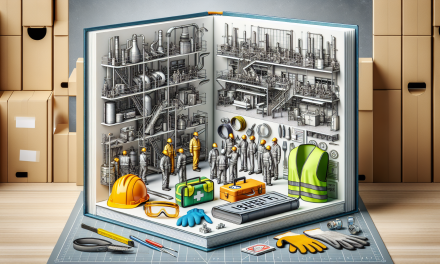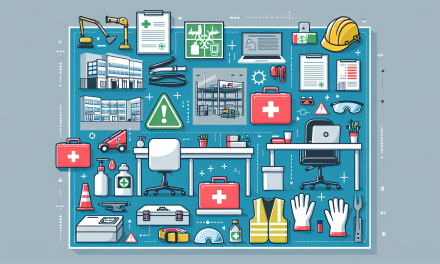Table of Contents
- Understanding Safety Technology
- The Importance of Risk Management
- Benefits of Comprehensive Training
- Key Components of Safety Technology
- Integrating Technology and Risk Management
- Creating a Safety Culture
- Emerging Trends in Safety Technology
- FAQs
- Conclusion
Understanding Safety Technology
In today’s fast-paced world, safety technology plays a crucial role in ensuring the well-being of employees across all industries. This technology encompasses tools, processes, and systems designed to mitigate risks and enhance safety protocols. By leveraging advancements in technology, organizations can identify hazards, monitor environments, and implement preventive measures effectively.
The Evolution of Safety Technology
Historically, safety measures relied heavily on manual processes and inspections. However, with the advent of digital innovation, safety technology has evolved substantially. Tracking systems, sensor technology, and data analytics have transformed how safety is monitored and managed. Consequently, this evolution enables organizations to respond promptly to emerging risks.
Key Avancements in Safety Technology
- Wearable devices that monitor worker health metrics and environmental conditions.
- Advanced software for risk assessment and incident reporting.
- Integration of artificial intelligence to predict potential hazards.
The Importance of Risk Management
Effective risk management forms the backbone of a successful safety program. Assessment and evaluation of potential risks allow organizations to allocate resources efficiently, minimize liabilities, and promote a safe working environment. Therefore, comprehensively addressing risks not only protects employees but also enhances organizational reputation.
Elements of Risk Management
Risk management comprises several critical elements, including:
- Risk identification: Recognizing potential hazards within the workplace.
- Risk analysis: Evaluating the likelihood and impact of identified risks.
- Risk control: Implementing strategies to reduce or eliminate risks.
Benefits of a Robust Risk Management Strategy
- Increased employee morale and productivity.
- Lower insurance premiums through effective risk mitigation.
- Enhanced compliance with industry regulations and standards.
Benefits of Comprehensive Training
Investing in comprehensive training for safety technology and risk management yields numerous advantages. Through structured training, employees gain the skills and knowledge required to navigate potential hazards competently. Moreover, training fosters a safety-minded culture that prioritizes health and security.
Why Training Matters
Proper training ensures that safety protocols remain effective and relevant. In addition, it empowers employees to identify unsafe practices and report hazards proactively. Consequently, this accountability helps create a safer workplace environment.
Real-World Applications of Training
Organizations that emphasize training often experience positive outcomes. For example, a construction company that invests in safety training reported a significant decrease in workplace accidents, illustrating the direct link between training and enhanced safety measures.
Key Components of Safety Technology
Understanding the core components of safety technology is essential for effective implementation. Certain elements function harmoniously to create a cohesive safety strategy.
Monitoring Systems
Monitoring systems consist of sensors and cameras that provide real-time data, allowing organizations to respond quickly to incidents. For instance, a chemical plant may use these systems to detect gas leaks, prompting an immediate evacuation if necessary.
Data Management Tools
Data management tools streamline information collection and analysis, enabling organizations to make informed decisions. By utilizing software solutions, businesses can access and interpret data effectively, thus enhancing safety protocols and risk assessments.
Integrating Technology and Risk Management
Bringing together safety technology and risk management enhances overall safety efficacy. Integrating these elements helps organizations create a comprehensive safety strategy tailored to their unique needs.
Collaborative Approaches
Successful integration relies on collaboration across departments. Engaging safety professionals, IT specialists, and management in the safety planning process ensures that all perspectives are considered. Coordination among teams fosters a culture of safety that permeates every aspect of the organization.
Creating a Safety Culture
A strong safety culture is vital for the long-term success of any safety program. When safety becomes ingrained in the organizational identity, employees are more likely to prioritize it in their daily operations.
Strategies for Building a Safety Culture
- Encourage open communication about safety concerns.
- Recognize and reward employees who demonstrate exemplary safety practices.
- Invest in ongoing training and development programs to keep safety top of mind.
Leadership’s Role in Safety Culture
Ultimately, leadership plays a pivotal role in shaping the safety culture. By prioritizing safety in decision-making and demonstrating commitment, leaders inspire employees to embrace safety as a core value.
Emerging Trends in Safety Technology
Staying ahead in the field of safety technology requires awareness of emerging trends. Cutting-edge developments regularly shape these trends, influencing how organizations approach safety.
Artificial Intelligence and Machine Learning
AI and machine learning have gained traction in safety technology. These innovations enable predictive analytics, helping to foresee and mitigate potential risks before they escalate.
Mobile Safety Applications
With the increase in smartphone usage, mobile safety applications have become more prevalent. These apps provide employees with instant access to safety resources, reporting tools, and emergency contacts, empowering them to act quickly when necessary.
FAQs
What is the primary goal of integrating safety technology and risk management?
The primary goal is to create a safer workplace by effectively identifying, assessing, and mitigating risks through the use of advanced technology.
How can leaders foster a strong safety culture?
Leaders can foster a strong safety culture by prioritizing safety in communications and decisions, providing resources for continuous learning, and actively engaging employees in safety initiatives.
Conclusion
In summary, understanding the critical interplay between safety technology and risk management is imperative for building safer workplaces. By embracing technological advancements, organizations can effectively manage risks and protect their most valuable asset—their employees. Furthermore, comprehensive training enhances employee competency and fosters a culture of safety. For those interested in diving deeper into these topics, the Advanced Safety Technology & Risk Management Training Course provides valuable insights and practical skills. Ultimately, organizations that prioritize safety technology and risk management will be better positioned to navigate future challenges and ensure a secure working environment for all.





